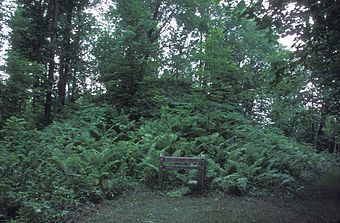Grand Mound (Minnesota) facts for kids
Quick facts for kids |
|
|
Grand Mound
|
|
 |
|
| Nearest city | International Falls, Minnesota |
|---|---|
| Area | 15.8 acres (6.4 ha) |
| NRHP reference No. | 11000565 |
| Added to NRHP | January 20, 1972 |
Grand Mound is an amazing ancient site in Koochiching County, Minnesota, USA. It's a very old burial ground built by people who lived there long ago. This site is the biggest prehistoric structure still standing in the upper Midwest. It dates back to about 200 BCE, which is over 2,200 years ago! Because it's so important, Grand Mound was named a National Historic Landmark in 2011.
Grand Mound: An Ancient Mystery
Grand Mound is a special place that tells us about the past. It is a prehistoric burial site, meaning it was used for burials long before written history. People from ancient times built these large earth mounds.
Exploring the Mounds
The main mound at Grand Mound is very large. It is about 140 feet long and 100 feet wide. It stands about 25 feet tall. This main mound also has a long "tail" that stretches for 200 feet. This tail is about 12 feet wide and 3 feet high.
At first, people thought the main mound was a simple round shape. But later, they discovered it had this long tail. This means it is an effigy mound. Effigy mounds are shaped like animals or other figures. Experts now think the Grand Mound might look like a muskrat.
Besides the main mound, there are four other smaller mounds at the site. These are more like the typical burial mounds found in the Midwest. The area also has signs of ancient villages. These villages were home to people during the Middle Woodland and Late Woodland times.
Respecting Ancient Sites
Grand Mound is part of a larger network of ancient places. These include old camping spots and fishing areas. They show how ancient people lived and used the land.
For a while, Grand Mound had a visitor center. It opened in 1975 and helped people learn about the site. However, the visitor center closed in 2003. The site itself was closed to the public in 2007.
This decision was made out of respect for the site. Tribal elders explained that Grand Mound is like a cemetery. It is a sacred burial ground. They felt that treating it as a tourist attraction was not appropriate. The Minnesota Historical Society agreed with this view. They wanted to honor the wishes of the tribal elders.



